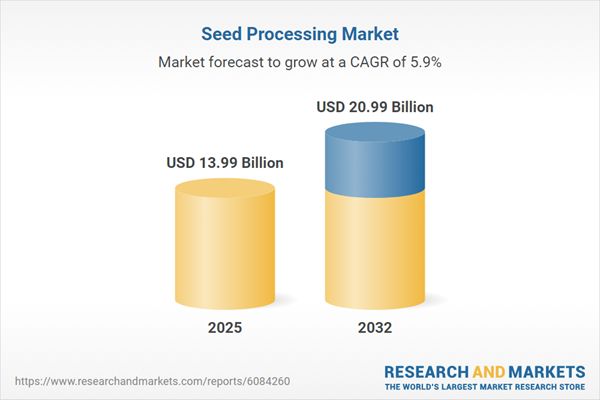Speak directly to the analyst to clarify any post sales queries you may have.
The seed processing market is entering a new phase, shaped by digitization, sustainability, and dynamic global trade. Senior leaders seeking a comprehensive view of the evolving seed processing landscape will find this report a critical tool for navigating operational, supply chain, and growth challenges ahead.
Market Snapshot: Seed Processing Market Overview
The Seed Processing Market grew from USD 13.22 billion in 2024 to USD 13.99 billion in 2025. It is expected to continue growing at a CAGR of 5.94%, reaching USD 20.99 billion by 2032. This market expansion is backed by rising food security needs, adoption of advanced seed technologies, and changing producer requirements worldwide.
Scope & Segmentation: In-Depth Industry Coverage
- Seed Types: Cereal (barley, maize, rice, wheat), oilseed (canola, rapeseed, soybean, sunflower), pulse (bean, chickpea, lentil, pea), and vegetable (cucumber, melon, pumpkin)
- Machinery Categories: Cleaning (air screen cleaners, aspiration systems, mechanical separators), color sorters (electronic, optical), drying (batch, belt, rotary dryers), hulling (abrasive mills, rubber rollers), shelling (impact shellers, roller shellers)
- End Use Applications: Animal feed (broiler, dairy, swine feed), food processing (bakery, confectionery, snack food), oil extraction (mechanical, solvent), seed production (certified, hybrid seed)
- Processing Capacities: Less than 1 T/H, 1–5 T/H, 5–10 T/H, greater than 10 T/H
- Regional Coverage: Americas (United States, Canada, Mexico, Brazil, Argentina, Chile, Colombia, Peru), Europe, Middle East & Africa (United Kingdom, Germany, France, Russia, Italy, Spain, Netherlands, Sweden, Poland, Switzerland, United Arab Emirates, Saudi Arabia, Qatar, Turkey, Israel, South Africa, Nigeria, Egypt, Kenya), Asia-Pacific (China, India, Japan, Australia, South Korea, Indonesia, Thailand, Malaysia, Singapore, Taiwan)
- Key Companies Covered: Bühler AG, GSI Group, Inc., Cimbria Holding A/S, Carter Day International, Inc., Satake Corporation, Key Technology, Inc., Petkus Technologie GmbH, Perten Instruments AB, Allrounder Maschinenbau GmbH, Ocrim S.p.A.
Key Takeaways for Seed Processing Stakeholders
- Technological innovation, including artificial intelligence integration and real-time monitoring, is raising operational precision and driving quality improvements across seed processing operations.
- Shifting focus toward sustainability is prompting investment in energy-efficient systems and waste reduction measures, which support environmental targets and deliver cost efficiencies.
- Producers and distributors increasingly demand traceability and transparency, with seamless integration between seed processors and farm management systems to ensure supply chain confidence.
- As industry players adapt to evolving market segmentation, flexible and modular machinery offers enhanced scalability, enabling companies to serve diverse seed types and capacities.
- Regional differences in policy, infrastructure, and climate lead to demand for tailored solutions, emphasizing the need for strategic agility and localization.
Tariff Impact: Navigating New Trade Measures
The introduction of 2025 United States tariffs has reshaped global seed processing supply chains, increasing costs for imported machinery and seed varieties. In response, many processors are adjusting sourcing strategies, pursuing supplier diversification, and enhancing inventory management. These geopolitical shifts have also accelerated innovation in remote diagnostics and after-sales services, helping organizations counteract regulatory-driven expenses and strengthen customer loyalty.
Primary Keyword Integration: Seed Processing Market
Competitive positioning in the seed processing market now relies on integrating automation, advanced analytics, and scalable machinery. Players leveraging these capabilities can deliver consistent seed quality and operational reliability, differentiating themselves in both established and emerging regions.
Methodology & Data Sources
This report leverages robust research, combining insights from in-depth interviews with process engineers, manufacturers, and supply chain specialists. Additional secondary analyses include trade publications, industry white papers, patent documents, and market data, cross-verified by an independent advisory panel.
Why This Report Matters
- Enables strategic decisions on capital investment, technology adoption, and market entry based on rigorous market segmentation and recent regulatory trends.
- Provides actionable guidance for navigating complexity introduced by global trade measures, regional disparities, and sustainability imperatives.
- Equips senior leaders with the necessary industry intelligence to identify growth opportunities and risk mitigation strategies for seed processing operations.
Conclusion
This report delivers a clear roadmap for navigating the evolving seed processing industry. Senior decision-makers can leverage its insights to enhance strategy, optimize operations, and build resilient, future-ready organizations.
Table of Contents
3. Executive Summary
4. Market Overview
7. Cumulative Impact of Artificial Intelligence 2025
List of Figures
Samples

LOADING...
Companies Mentioned
The key companies profiled in this Seed Processing market report include:- Bühler AG
- GSI Group, Inc.
- Cimbria Holding A/S
- Carter Day International, Inc.
- Satake Corporation
- Key Technology, Inc.
- Petkus Technologie GmbH
- Perten Instruments AB
- Allrounder Maschinenbau GmbH
- Ocrim S.p.A.
Table Information
| Report Attribute | Details |
|---|---|
| No. of Pages | 196 |
| Published | October 2025 |
| Forecast Period | 2025 - 2032 |
| Estimated Market Value ( USD | $ 13.99 Billion |
| Forecasted Market Value ( USD | $ 20.99 Billion |
| Compound Annual Growth Rate | 5.9% |
| Regions Covered | Global |
| No. of Companies Mentioned | 11 |









